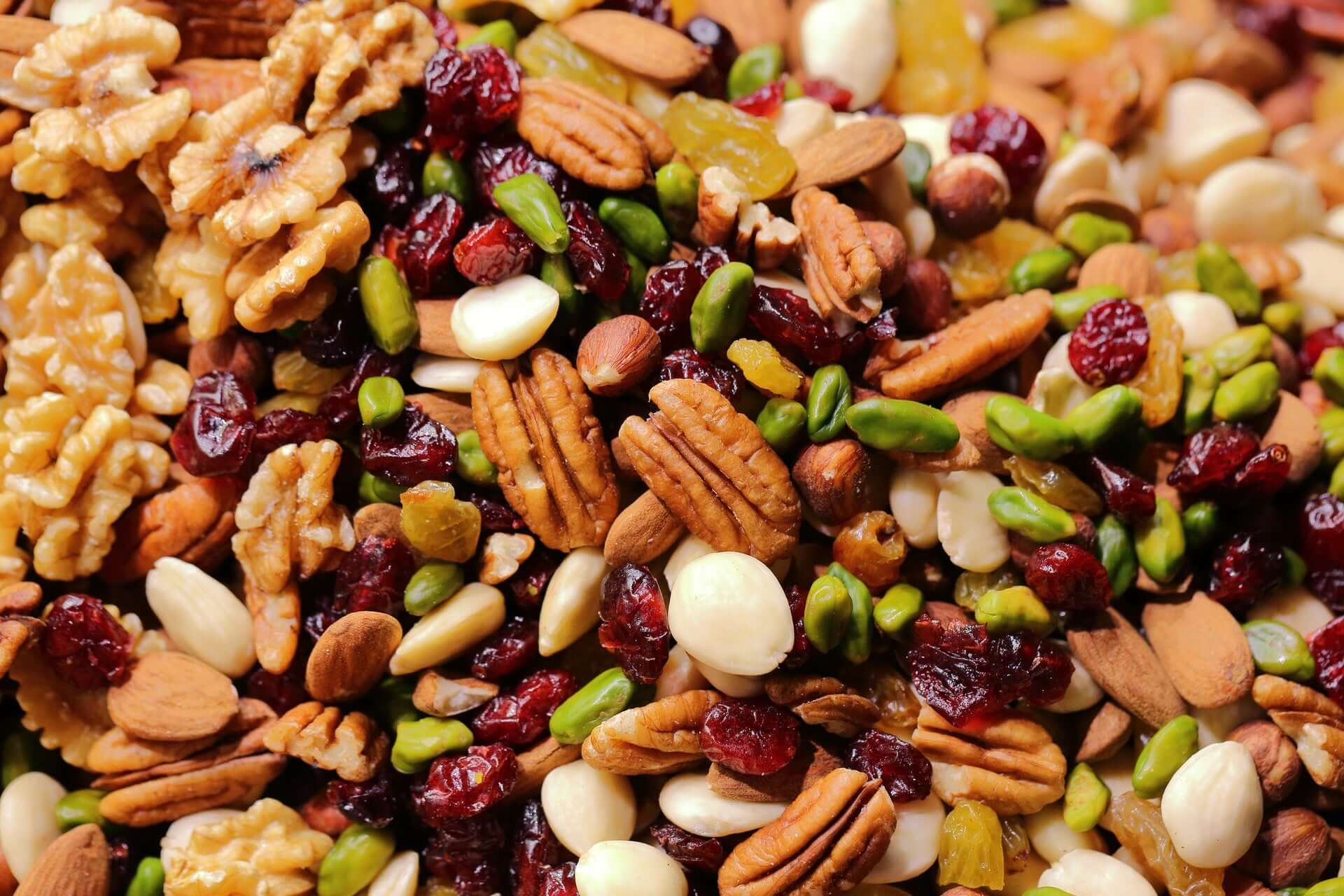
Inhaltsverzeichnis
Nüsse – klein, aber oho!
Von allen Seiten wird einem geraten, mehr Nüsse zu essen. Schließlich sind sie doch so gut für uns. Aber wieso eigentlich? Und: Welche Nüsse sind besonders gesund?
Gesundheitliche Vorteile von Nüssen
Nüsse heißen eigentlich Nussfrüchte und sind aus botanischer Sicht sogenannte Schließfrüchte, deren Fruchtwand aus drei verholzten Schichten besteht. Wie du sicherlich weißt, gibt es eine ganze Menge verschiedener Nusssorten: Haselnüsse, Walnüsse, Macadamianüsse, Erdnüsse… Aber Moment! Denn Erdnüsse sind eigentlich keine “echten” Nüsse, sondern zählen zu den Hülsenfrüchten. Andersherum gibt es auch Nüsse, die wir gar nicht als Nüsse kennen. Als Beispiel sei hier die Hanfnuss genannt, die bei uns eher als Hanfsamen bekannt ist.
Was macht Nüsse denn nun so gesund?
Angefangen mit Eiweiß und Magnesium, über Zink und gesunde Fette bis hin zu Antioxidantien und wertvollen Spurenelementen: Nüsse sind kleine Kraftpakete und enthalten allerlei “gutes Zeug”. Einige Ernährungswissenschaftler:innen bezeichnen Nüsse daher als einen “perfekten Kompromiss zwischen Fleisch und Gemüse”.
Jede Nuss hat dabei ihre ganz spezifischen Vorteile. Auf die kommen wir gleich noch genauer zu sprechen.
Allen Nüssen gemeinsam ist aber, dass sie viele Mineralien und Vitamine enthalten. Auch die in Nüssen enthaltenen Antioxidantien sind sehr essentiell, da diese freie Radikale “fangen” und den Körper vor Zellschädigung schützen. Nüsse stärken also unsere Immunkräfte.
Besonders bekannt sind Nüsse auch durch ihre positiven Auswirkungen auf die Gesundheit unseres Herzens und unserer Verdauung, von Haut und Haar sowie bei der Regulierung von Bluthochdruck.
Vor einiger Zeit galten Nüsse aufgrund ihres hohen Fettgehalts noch als Dickmacher. Heute weiß man jedoch, dass es sich bei den in Nüssen enthaltenen Fettsäuren um gesunde Fette handelt, die viele gesundheitliche Vorteile mit sich bringen. Dazu ein wenig mehr:
Omega-3- und Omega-6-Fettsäuren regulieren Entzündungsprozesse in unserem Körper. Während Omega-6-Fettsäuren entzündungsfördernd wirken, bilden Omega-3-Fettsäuren den entzündungshemmenden Gegenpol. Damit es nicht zu Entzündungskrankheiten kommt, muss in unserem Körper eine ausgewogene Balance zwischen beiden Fettsäurearten herrschen. Ein Verhältnis von 2,5:1 (Omega-6:Omega-3) wird als entzündungsneutral betrachtet. In unserer Bevölkerung liegt das durchschnittliche Verhältnis jedoch bei 15:1! Es ist daher wichtig, dass wir mehr Omega-3-Fettsäuren zu uns nehmen und weniger Omega-6-Fettsäuren (die übrigens sehr viel in Sonnenblumen- und Sojaöl enthalten sind sowie in Tierfutter, was wir dann über den Konsum von Fleisch ebenfalls zu uns nehmen). Neben Fisch sind Nüsse eine sehr wertvolle Quelle für Omega-3-Fettsäuren.
Um unsere allgemeine Gesundheit in Schach zu halten ist der regelmäßige Verzehr von Nüssen also sehr vorteilhaft. ☺️
Was muss ich beim GeNUSS (😆) von Nüssen beachten?
Weil Nüsse auch viele Kohlenhydrate enthalten, sollte man sie in Maßen genießen. Eine handvoll Nüsse am Tag ist die Menge, die allgemein empfohlen wird. Die handvoll kann dabei aus ganz verschiedenen Sorten bestehen: z.B. 2 Paranüsse, 2 Walnüsse, 3 Mandeln, 3 Erdnüsse und 2-3 Macadamianüsse. Durch eine Mischung wie diese wird sowohl der Selenbedarf unseres Körpers, als auch der tägliche Vitamin-E-Bedarf bestens abgedeckt.
Die Nüsse muss man nicht immer zusätzlich zum sonstigen Essen essen, sondern kann sie auch mal anstelle von Wurst oder Käse genießen. Nüsse sollte man zudem immer gut kauen.
Beim Kauf von Nüssen sollte auf Bio-Qualität und möglichst auch auf Regionalität geachtet werden. Mandeln kommen beispielsweise ursprünglich aus dem Mittelmeerraum; die größten Anbaugebiete befinden sich heutzutage aber in Kalifornien, in den USA. Das bringt lange Transportwege mit sich, was für den CO2-Abdruck natürlich nicht besonders gut ist.
Häufig sind die Nüsse vor dem Kauf bereits gesalzen und / oder geröstet. Am besten ist es jedoch, möglichst unbehandelte Nüsse zu kaufen. Auch ist es vorteilhaft, ganze Nüsse zu besorgen und diese nach Bedarf zu zerkleinern, da sie sonst schnell ranzig werden.
Sie können pur als Snack genossen werden, geröstet zum Salat gegeben werden, als Topping für verschiedenste herzhafte Gerichte dienen oder in Form von Nussmus ins Porridge oder in den Smoothie gegeben werden.

Photo by Marcia Cripps on Unsplash
Besonders gesunde Nüsse und ihre jeweiligen Vorzüge
Bevor ich genauer auf ausgewählte Nusssorten zu sprechen komme, sei gesagt, dass jede Nuss gewisse Vorteile hat und keine Nuss wirklich ungesund ist. Ich habe mich dazu entschieden, fünf Sorten hervorzuheben, die besonders für ihre gesundheitlichen Vorzüge bekannt sind und zu deren Eigenschaften bereits viel geforscht wurde.☺️
1. Walnüsse
Walnüsse gehören zu den bekanntesten Nusssorten. Eine bestimmte Omega-3-Fettsäure, die in Walnüssen enthalten ist, ALA, stärkt das Herz und wirkt sich positiv auf den Cholesterinspiegel aus. Auch der hohe Zinkgehalt ist hervorzuheben, denn der ist wichtig für ein funktionierendes Immunsystem und für unsere Wundheilung.
Nicht nur wegen ihres Aussehens wird die Walnuss häufig mit unserem Gehirn in Verbindung gebracht. Der Verzehr von Walnüssen fördert die Durchblutung im gesamten Körper, und eben auch im Kopf. Andere “gehirnförderliche” Eigenschaften, die der Walnuss zugeschrieben werden, sind jedoch zur Zeit meist noch spekulativ.
Walnüsse wachsen übrigens auch in Deutschland.
2. Mandeln
Mandeln sind strenggenommen keine Nüsse, sondern Steinfrüchte. Sie enthalten viel Eiweiß, Vitamin B2, Vitamin E und Magnesium. Das Vitamin B2 spielt eine wichtige Rolle bei der Abwehr von Krankheiten. Mandeln enthalten darüber hinaus eine ganze Menge an Folsäure, was besonders in der Schwangerschaft wichtig ist.
In unseren Supermärkten sind Mandeln in verschiedensten Varianten erhältlich: Gehackt, gemahlen, mit oder ohne Schale... Apropos Schale: Viele wichtige Inhaltsstoffe, unter anderem die Ballaststoffe, stecken in der Haut der Mandel. Wer die volle Power der Mandel mitnehmen möchte, sollte daher auf ungeschälte, rohe Mandeln zurückgreifen.
3. Haselnüsse
Sie gehört zu den ältesten Nusssorten Europas und und ist auch heute noch bei uns heimisch: Die Haselnuss. Sie ist dabei ein wahrer Alleskönner: Ballaststoffe, viel Eiweiß, Zink, Eisen, Vitamin E und gesunde Fettsäuren… Eine Schande, dass die Haselnuss so oft unterschätzt wird!
Ihre Inhaltsstoffe schützen unsere Körperzellen vor schädlichen Einflüssen, bringen unsere Verdauung in Schwung und liefern Energie für unsere Muskeln.
Besonders gut schmecken Haselnüsse, wenn sie geröstet werden. Durch das Rösten reagieren die Eiweißstoffe mit enthaltenen Zuckersubstanzen. Dabei wird das Aroma erst so richtig entfaltet. In diesem Zustand passen sie bestens zu Salat oder als Topping auf Backwaren. Beachte hierbei aber bitte, dass die enthaltenen ungesättigten Fettsäuren durch das Rösten empfänglicher für Schäden bzw. Oxidation werden. Daher solltest du nicht zu häufig auf geröstete Nüsse zurückgreifen. Unbehandelt sind Nüsse schließlich immer noch am besten für unsere Gesundheit. 🤗
4. Paranüsse
Paranüsse erfreuen sich in den letzten Jahren immer größerer Beliebtheit. Zwar sind sie schon seit langer Zeit fester Bestandteil von Studentenfutter, aber pur bzw. einzeln werden sie erst seit kurzem wirklich gefeiert. Grund für die steigende Popularität der Nuss ist ihr hoher Selenanteil. Das Spurenelement Selen schützt vor Krebserkrankungen, indem es unter anderem Schwermetalle bindet und entgiftet. Auch für die Schilddrüse ist dieses Spurenelement von Bedeutung.
Ein Selenmangel kann super durch den Verzehr vo 1-3 Paranüssen pro Tag ausgeglichen werden. In vielen Fällen ist bereits nach 6-12 Wochen keine Mangelerscheinung mehr zu beobachten.
Im Vergleich zu anderen Nüssen enthält die Paranuss mehr einfach gesättigte Fettsäuren, was sie dennoch keineswegs zu einer “schlechten” Nuss macht.
Paranüsse werden vor allem in Mittel- und Südamerika angebaut.
5. Cashews
Diese Nuss ist reich an Magnesium, Kalium, Eisen und Eiweiß. Diese Inhaltsstoffe helfen dabei, Herz-Kreislauf-Erkrankungen vorzubeugen und einen hohen Cholesterinspiegel auszugleichen Zudem enthalten sie auch die Aminosäure Tryptophan, welche eine Vorstufe des Glückshormons Serotonin darstellt!
Die reichlich in Cashews enthaltenen B-Vitamine können gegen Müdigkeit und Konzentrationsschwierigkeiten helfen.
Übrigens sind Cashewkerne im Vergleich zu anderen Nüssen fettärmer und haben daher weniger Kalorien.
Welche Nuss ist dein Favorit? Schreib’ es uns gerne unten in die Kommentare unter diesem Post! 🥜
Wenn du noch mehr über gesunde Ernährung, Achtsamkeit, Nachhaltigkeit oder Familie und Schwangerschaft erfahren möchtest, schaue dir hier noch mehr spannende Blog-Artikel zu diesen Themen an.
Photo by Jenn Kosar on Unsplash



























Leave a comment
This site is protected by hCaptcha and the hCaptcha Privacy Policy and Terms of Service apply.